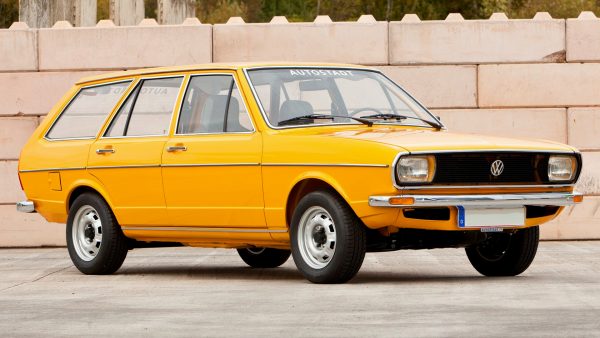
Volkswagen Passat: history, lineup, characteristics
Content
Volkswagen Passat cars have always been and remain very popular. This is due to a successful combination of consumer characteristics (size, appearance, reliability, etc.) and price. Currently, the eighth generation of the Volkswagen Passat is being produced.
History and evolution of the VW Passat
The first Volkswagen Passat models rolled off the assembly line in 1973. Over the following decades, the car became extremely popular - the eighth generation of the Passat is now being produced.
VW Passat B1 (1973-1988)
The first generation VW Passat B1 was a modification of the Audi 80 with petrol engines of 1,2–1,6 liters and a 1.5-liter diesel engine. The basis of the front suspension was made up of McFerson struts, and at the rear there was a continuous axle with coil springs. The front brakes were disc, rear - drum. The model was produced not only in Germany, but also in Brazil, South Africa and Nigeria. Now it is quite difficult to find such cars, and the price of some copies reaches 150-180 thousand rubles.

VW Passat B2 (1981-1988)
The next generation VW Passat B2 was released in 1980. Manufacturers refused to copy Audi. A semi-independent suspension was installed on the VW Passat B2. In addition, as part of the expansion of the model range, the VW Passat Santana sedan was released. The following engines were installed on cars:
- gasoline with a volume of 1,3 liters and a capacity of 55 liters. With.;
- gasoline with a volume of 1,6 liters and a capacity of 75 liters. With.;
- gasoline with a volume of 1,9 liters and a capacity of 115 liters. With.;
- diesel with a volume of 1,6 liters and a capacity of 54 liters. With.
Currently, such a car in working order can be found for 50-150 thousand rubles.
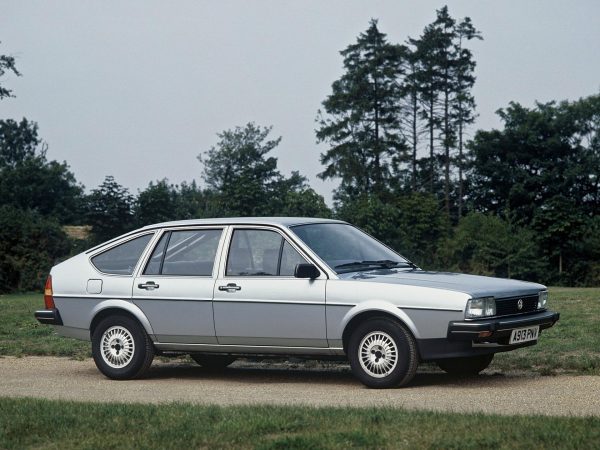
VW Passat B3 (1988-1993)
VW Passat B3 was introduced in February 1988. The model was based on a different platform, on which the engine was located across the body. The car was produced only in Germany and was equipped with gasoline units with a volume of 1,6–2,0 liters and a power of 72–136 hp. With. Diesel engines were also offered: turbocharged (1,6 and 1,9 liters) and atmospheric (1,9 liters). The most powerful was the VR6 gasoline engine (2,8 liters, 174 hp). An all-wheel drive version was also present in the Passat B3 lineup.
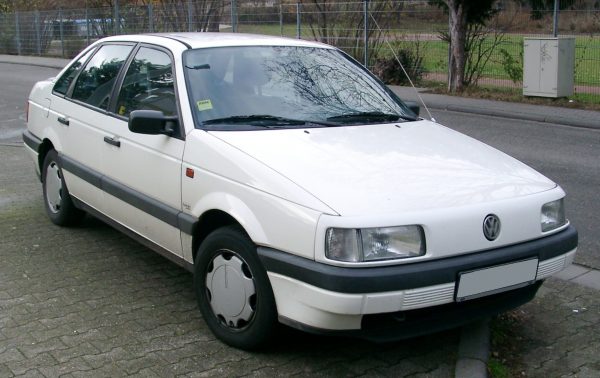
VW Passat B4 (1993-1997)
The fourth generation VW Passat B4, introduced in 1993, was fundamentally different from previous models. In addition to the traditional four-door models, the production of the five-door station wagon VW Passat Variant began. Galvanization of the body elements most exposed to moisture provided the car with anti-corrosion resistance. In the basic version, there were airbags on the driver and passenger sides, a system against breaking door locks, and since 1993, an immobilizer. In addition to the standard four-cylinder engines with a capacity of 75–150 hp. with., some versions were equipped with a VR6 unit with six cylinders with a capacity of 174 and 190 liters. With. VW Passat B4 was produced only four years. Now such a car on the domestic market can be purchased for 100-200 thousand rubles.
Video: review of the fourth generation VW Passat
VW Passat B5 (1996-2005)
VW Passat B5, which began production in 1996 in Germany, was a completely new model. The car was designed using units from the Audi A4. In addition, the front multi-link aluminum suspension and a number of other components were inherited from the latter. When developing a fully galvanized body, aerodynamics and passive safety requirements were taken into account. The appearance of the VW Passat B5 has become more solid and prestigious.
As a result of restyling in 2000, bumpers, front and rear lighting devices, interior and front suspension were changed. Even in the basic configuration there was climate control, ABS, front power accessories and two airbags. The buyer was offered a choice of 17 engine versions. In Russia, the 1,8-liter gasoline unit with a turbine has become the most common. Somewhat less common were engines of 2,0 and 2,8 liters and turbocharged 1,9-liter diesel engines. Other options from the line of motors practically did not come across.
The first versions of the VW Passat B5 were equipped with a five-speed manual gearbox, which, after restyling, became a six-speed one. In addition, after 2000, four-speed automatic transmissions and a five-speed tiptronic were installed on some models. Depending on the condition, you can now buy a VW Passat B5 for 200-350 thousand rubles.
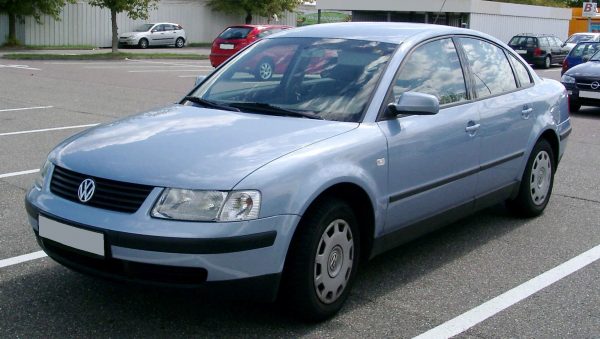

VW Passat B6 (2005-2010)
The sixth generation of the VW Passat was released in 2005. The basic equipment of the Passat B6 was equipped with a 102 hp atmospheric engine. With. In addition, it was possible to equip the car with another power unit from the line:
- FSI engine with direct fuel injection with a volume of 1,6 liters and a power of 115 hp. With.;
- FSI engine with direct fuel injection with a volume of 2,0 liters and a power of 150 hp. With.;
- turbocharged TSI engine with a volume of 1,4–2,0 liters and a power of 122–200 hp. With.
All cars had a transverse arrangement of the power unit. Consumers were offered versions with manual, automatic and robotic (DSG) transmissions. In addition, it was possible to choose between a sedan and station wagon. Prices for the Passat B6 currently start at 300 thousand rubles.
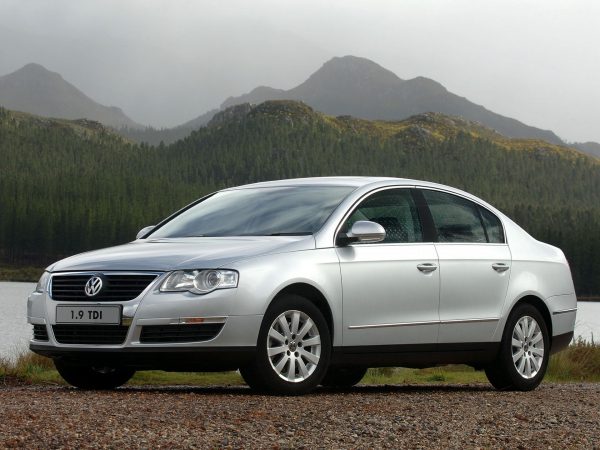

VW Passat B7 (2010-2015)
The next generation VW Passat was a radically redesigned previous model, although inside the changes were almost imperceptible. The list of options has increased, and better materials have been used in the interior trim. A choice of turbocharged gasoline engines of 1,4–2,0 liters with a capacity of 120–210 hp was offered. With. and diesels 1,6 TDI and 2,0 TDI with a capacity of 105–177 hp. With. In Russia, prices for the VW Passat B7 at the beginning of sales started at 860 thousand rubles. Now such a car can be purchased for 600 thousand rubles. and higher.
Video: review of the seventh generation VW Passat


Watch this video on YouTube
VW Passat B8
VW Passat B8 began production in 2014. Despite the hereditary features from previous versions, the engineers have changed the new model almost beyond recognition. Externally, the car looks like a monolith, and the interior has become more comfortable and spacious. Moreover, the buyer can choose the color of the interior trim - light trim will add luxury and presentability to the car. The eighth generation is equipped with TSI petrol engines (1,4–1,8 liters and 125–180 hp) or TDI diesel (240 hp). The power units are paired with a manual or robotic (DSG) gearbox. The new car can be attributed without stretch to the premium segment. The VW Passat B8 costs in Russia no less than 1,5 million rubles.
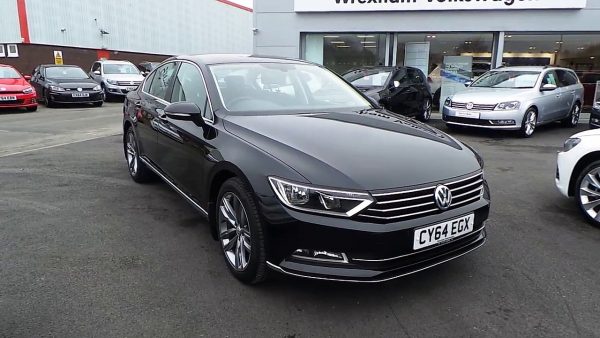

VW Passat CC
The business-class VW Passat CC was introduced in 2008 and updated in 2012. The new model was an intermediate between the VW Passat and VW Phaeton. It was developed on the basis of the Passat B6 and began to be produced in the city of Emden. The VW Passat CC differs from the usual Passat in size and minor changes in the cabin - a new steering wheel and door trim, front seats with good lateral support and a different button design on the control panel. Despite the similarity with the base model, individual features can be traced in the appearance of the VW Passat CC.
According to the technical characteristics of the VW Passat CC, it fully corresponds to the seventh generation of the sedan. Despite the fact that the base model has changed generation, the coupe has not undergone any changes. Three types of gasoline engines (1,8–3,6 liters and 152–280 hp) or diesel can be installed on the car. All VW Passat SS have a sports suspension, which is mounted on shock absorbers and coil springs.


Main characteristics of VW Passat
Specifications VW Passat changed as the model evolved.
Table: the main characteristics of the Volkswagen Passat lineup
| model year | 1973 – 1988 Feet | 1981 – 1988 Feet | 1988 – 1993 Feet | 1993 – 1997 Feet | 1996 – 2005 Feet | 2005 – 2010 Feet | 2010 – 2015 Feet | 2014 | CC (2008-) | ||
| body type | hatchback | sedan, hatchback | sedan | sedan | sedan, station wagon | sedan, station wagon | sedan, station wagon | sedan, station wagon | compartment | ||
| length, mm | 4190 | 4529 | 4580 | 4600 | 4681 | 4760 | 4769 | 4867 | 4798 | ||
| width, mm | 1620 | 1709 | 1699 | 1720 | 1740 | 1821 | 1820 | 1834 | 1854 | ||
| height, mm | 1358 | 1400 | 1430 | 1430 | 1461 | 1471 | 1470 | 1486 | 1417 | ||
| trunk volume, l | 450 | 535 | 578 | 495 – 1500 Feet | 475 – 1545 Feet | 475 – 1730 Feet | 565 – 1730 Feet | 586-1780 | 532 | ||
| Number of doors | 5 | 4,5 | 4 | 4 | 4/5 | 4/5 | 4 | 4 | 4 | ||
| number of seats | 5 | 5 | 5 | 5 | 5 | 5 | 5 | 5 | 4 | ||
| weight, kg | equipped | 900 | 960 | 1200 | 1230 | 1200 | 1345 | 1460 | 1387 | 1500 | |
| full | 1350 | 1500 | 1760 | 1790 | 1870 | 1950 | 2030 | 1910 | 1900 | ||
Exterior and interior
Italian designer Giorgetto Giugiaro worked on the style of the first generation VW Passat. The model was produced with several types of headlights - two or four round and two rectangular. In North America, the Passat B1 was shipped with only two round headlights.
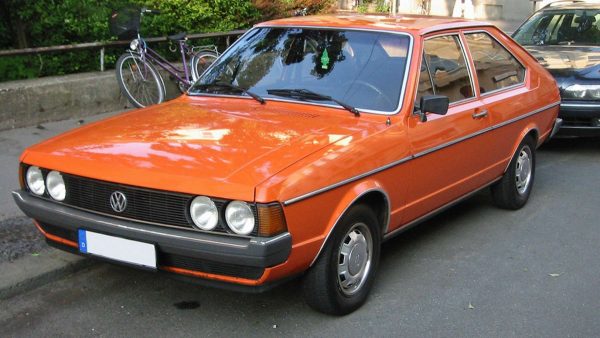

In 1977, a restyling was carried out. The front part of the body has changed, becoming more streamlined, and rectangular headlights were installed in the basic version. There were new taillights, and the steel bumpers were replaced with plastic ones. Salon Passat B1 at the same time remained virtually unchanged and remained quite spacious.


The second generation, due to the use of a new platform, turned out to be somewhat longer than the first, and rectangular headlights became a characteristic feature of the entire family for a long time. In 1986, the car was slightly modified.
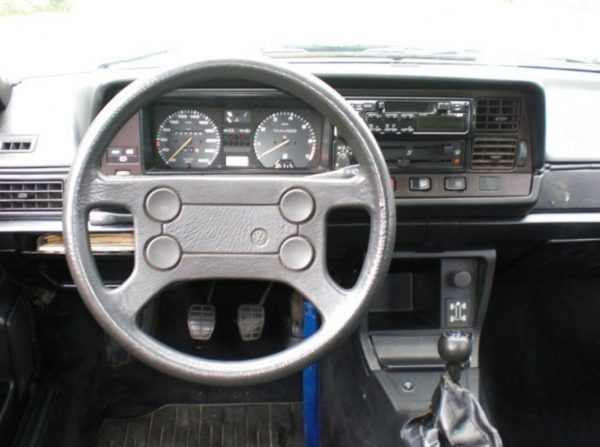

The increased popularity of the VW Passat B3 was due to a spacious and comfortable interior, modern appearance, and a large trunk. A distinctive feature of the model was the headlights in the form of a single block and the absence of a radiator grille. The salon has also changed markedly.
Video: review of the third generation VW Passat


Watch this video on YouTube
The fourth generation VW Passat differed from the third in appearance (body panels) and interior. A radiator grill appeared, made in the style of other Volkswagen models, the headlights, taillights, both bumpers, trunk lid and hood have changed, and the side parts of the body have become more gentle. The interior has been updated trim, door handles and lighting control panel.
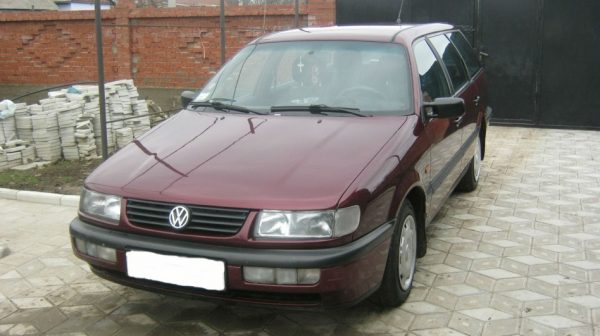

In fifth-generation cars, aerodynamics were noticeably improved - the drag coefficient became equal to 0,29. The body of the VW Passat B5, made of high quality materials, has maintained a good appearance for a long time. The changes made to the model in 2001, for the most part, affected the exterior. Updated bumpers, grille, front and rear lights, chrome body elements. The interior has also changed, the most spacious in this class of cars. It is distinguished not only by the quality of the materials used, but also by the assembly close to Audi. Interior design was comfortable and reliable. The only drawback is the unsuccessfully executed backlighting of the dashboard and buttons.
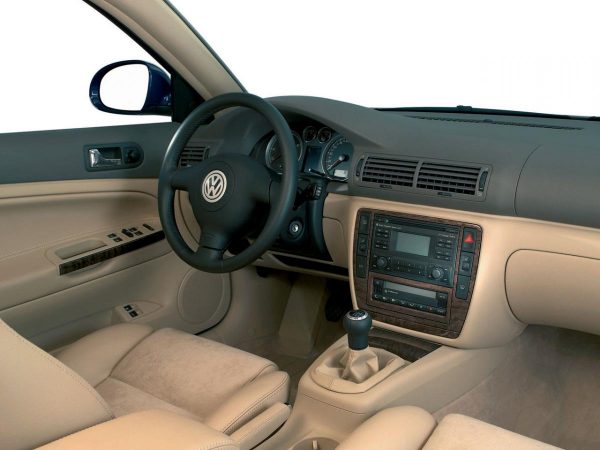

VW Passat B5 was presented in the traditional style for the German manufacturer. Compared to competitors, he looked quite modest. However, the car stood out for its complex front optics, a streamlined profile with a sloping roof and a massive rear end equipped with lamps with LED elements. Quite large dimensions and chrome elements added solidity to its appearance.


Salon VW Passat B6 is made in a calm and concise style. The instrument panel features slightly recessed dials with a chrome finish. On the center console is an audio system with a monitor and a climate control panel in the cabin. The salon, trimmed depending on the configuration with genuine leather, high-quality plastic and aluminum, is spacious and has impeccable ergonomics. Simple-looking front seats are very comfortable, have good lateral support and are adjustable in a wide range. The back seat can accommodate three passengers.
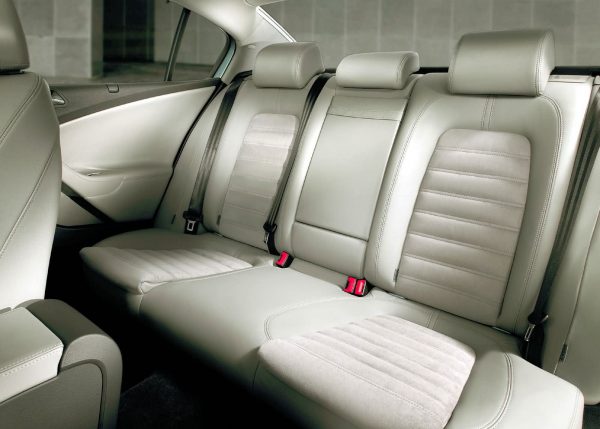

The seventh generation of the VW Passat is characterized by a strict and modest appearance characteristic of the concern. Between the enlarged headlights is a narrow grille, consisting of four chrome-plated jumpers. Pretty neat front bumper has an additional air duct, an aerodynamic lip at the bottom and fog lights. Two side ribs of the hood smoothly pass into the wheel arches. Horizontally located large lights in the rear look harmoniously with a neat bumper and trunk lid. The VW Passat B7 station wagon has a large rear door that goes deep into the bumper profile with its lower edge and is equipped with small lamps compared to the sedan.
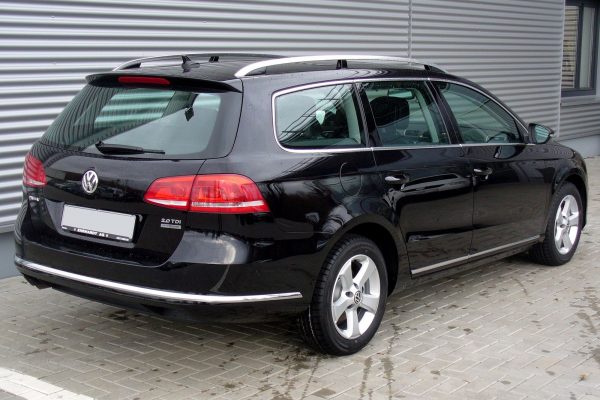

Interior trim VW Passat B7 even in the basic version looks quite expensive. The heavily padded front seats with good lateral support are very comfortable, especially for long trips. The steering wheel is adjustable in height and depth. The dashboard has a large tachometer and speedometer, and between them is a screen with many functions. The dashboard and center console are made in a conservative style with solid wood inserts, which is inherent in more expensive trim levels. The seats and controls are ergonomic, the instruments are informative, and the materials and build quality of the cabin are at the highest level. The rear can accommodate three people, but the passenger sitting in the center will be uncomfortable with the central tunnel and ventilation elements.
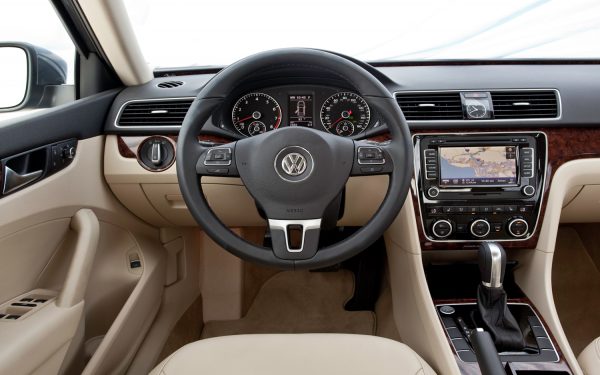

The appearance of the new VW Passat B8 differs from the seventh generation primarily in the headlights with LED strip. The radiator grill has become narrower. The edges of the front bumper have become sharper, and the fog lights integrated into it have taken on a compact look. Two exhaust pipes are installed along the edges of the rear bumper, and new rear lights make it look like a Passat CC.
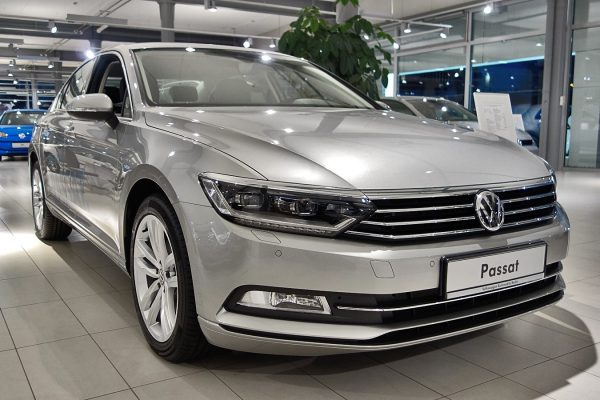

The interior has also changed markedly and has become almost ideal in terms of ergonomics. High-quality finishing materials, a large number of chrome-plated elements give the interior a solid look. Fabric-covered seats as standard have a little lateral support, heating and a number of additional adjustments. It should also be noted the beautiful design of the rear triple sofa.


The dashboard of the VW Passat B8 depends on the configuration. In the basic version, it has analog sensors and a small on-board computer. The control panel is fully equipped with a display, which displays an imitation of analog devices and other information. The new multifunction steering wheel features a truncated rim. On the center console is a touch screen multimedia system with a diagonal (depending on configuration) from 5 to 8 inches with additional controls on the sides. Below is the climate control unit.
Video: Volkswagen Passat B8 2014 review


Watch this video on YouTube
The eighth generation also includes an updated VW Passat CC, which is equipped with bi-xenon headlights with LED backlighting, a new bumper and grille. The rear of the car also has a new bumper and lights with LED elements.


VW Passat CC has a two-tone interior trim, inside which there are no unnecessary elements, and the quality of materials and assembly are at the highest level. At the same time, the controls have an adjustable backlight.


Fuel consumption
An important criterion when choosing a car is the average fuel consumption. For the VW Passat of the last four generations, it varies from 4,6 to 13,2 liters per 100 kilometers. Such a wide range of this parameter is due to the direct dependence of fuel consumption on the type and power of the engine, style and operating conditions of the machine. The first four generations of the VW Passat consumed between 7,0 and 12,0 liters per 100 km. Experts believe that the optimal fuel consumption should be about 6 liters per 100 km.
The reduction in fuel consumption on the latest VW Passat models was achieved thanks to the manufacturability of the engines and the use of the DSG-7 gearbox, which fully reveals the potential of the power unit. So, VW Passat B8 with a base engine of 1,4 liters and 125 hp. With. and DSG-box in mixed mode consumes 5,0 liters per 100 km. The same 150 hp engine. With. consumes 5,1 liters per 100 km, and the most powerful engine (1,8 liters and 180 hp) - 5,8 liters. The fuel consumption of the 2,0 TDI diesel is 4,0-5,2 liters.
Video: 1997 VW Passat fuel consumption


Watch this video on YouTube
Advantages and disadvantages of gasoline and diesel engines
The VW Passat is equipped with both petrol and diesel engines. Both of them have their advantages and disadvantages. Thus, the 2,0 TDI diesel engine generates 4200 Nm of torque at 320 rpm. These are quite high figures for a diesel engine. Such units are installed on the VW Jetta, VW Golf, VW Tiguan and VW Passat.
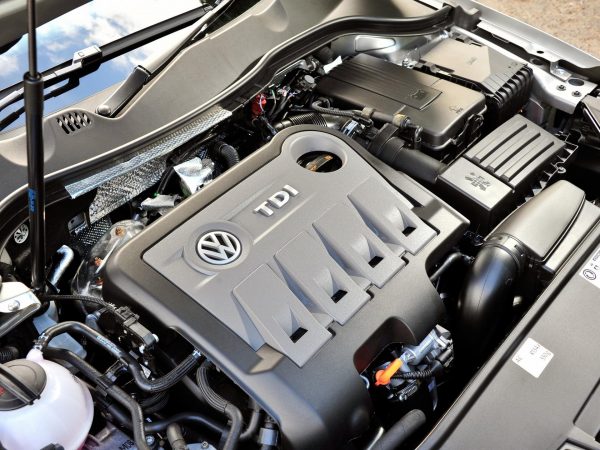

Such an engine consumes no more than 7 liters of fuel per 100 km, while its gasoline counterpart consumes at least 8 liters. In addition, diesel is more durable, which is also important. However, FSI gasoline engines are less sensitive to fuel quality, and for Russia this is very relevant. That is, a VW Passat with a gasoline engine is easier to operate. If you fill TDI with low-quality fuel, then the nozzles will quickly fail.
Repair of gasoline units will cost an average of 15% cheaper than diesel ones. In addition, diesel engines warm up longer, work noisily, and if they are refueled with summer fuel in winter, it will be quite difficult to start them. That is, the fuel used must be given special attention. When working with a diesel engine paired with a manual transmission, the gears will have to be switched more often than with a gasoline engine.
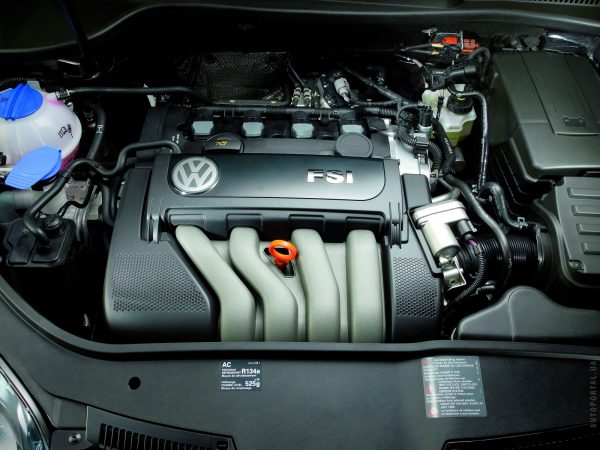

Build VW Passat and owner reviews
It is generally accepted that the country in which the car is assembled directly affects its quality.
Assembly Technology VW Passat
VW Passat assemble:
- in Germany (Wolfsburg and Emden);
- in China;
- in Malaysia;
- in Russia (Kaluga) - until 2010.
The opinion that German cars are assembled with high quality only in Germany is erroneous. However, for our market, the VW Passat is only supplied from Germany. The conveyor line for the production of the VW Passat operates in Wolfsburg. Full assembly of the car is carried out in 48 hours. This guarantees high precision and no less high quality. In the first workshop, individual components and parts are welded and the outlines of the body are created. Then, with the help of electronic systems, the quality of the structure is checked - the lines of the seams are measured and their straightening is done. If a marriage is found, the body is finalized or immediately disposed of.
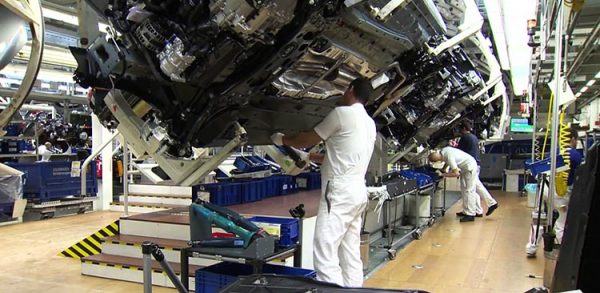

After that, the frame is painted, dried and proceed with the installation of interior elements, electronic equipment and control panels. The next step is to install the transmission and engine. Then, lights and decals of the company are put on the car. At the final stage, the car is tested on the track and, in case of positive results, is sent to a future buyer. Otherwise, the machine is returned for revision. Thus, it is simply impossible to purchase a VW Passat with any kind of marriage.
Reviews car owners
Volkswagen Passat 1.8 TSI 2016
Before the Passat, I drove an Audi A4 and it completely suited me. I wanted to take the same new Audi, but the prices for them are too high, so I preferred the Passat at maximum speed. I frankly do not like the appearance, but inside it gives the impression of a car of a more expensive class. The interior is more spacious, the trunk is larger, there is also plenty of space for passengers. Comfortable fit, good visibility. There are parking sensors in a circle and a rear camera. Windshield and heated steering wheel. The headlights are adaptive, perfectly illuminate the road, do not blind oncoming traffic. Manageability is also on the level. The car is quite dynamic. The motor is economical, consumes about 8 liters in the combined cycle. However, I consider the combination of a 1,8 liter engine and a DSG robot not entirely successful. When starting off, the box dulls, gradually accelerating, trying to quickly switch to higher gears, which is not necessary from it. I have to drive in sport mode, half pedal. I consider the start-stop system to be a disadvantage, which turns off the engine and electric power steering even before it comes to a complete stop. With a heat of +30 in the summer, a slight detonation appeared, switched to 98 gasoline, disappeared, but now fuel costs have increased.
Volkswagen Passat 2001
Already the third "Passat" B5, I like the design, despite its age, it is relevant, it looks modern. The reliability of the simplest engine is simply excellent. The dynamics of a 1,6 motor is a little lacking for such a machine, but it is quite possible to adapt, unless, of course, you load 5 people or drag a trailer. About zhor oil - this is who does not follow the car, of course, if with a turbine, then this fact will be, but there was a 1,8 turbo, everything was fine too. You just need to know the features of such motors and follow the necessary recommendations and everything will be fine. Inside, everything suits, many speak badly about the multi-link suspension, this is probably someone unfamiliar with it. Considering our roads, of course, it is more gentle, but with a courteous ride it lives normally.
Pros: comfortable, large, still relevant design, inexpensive to maintain, large trunk.
Cons: weak power windows (cables break), expensive front suspension (you can take cheap parts, but it's more expensive for yourself). Nevertheless, the 1,6 engine for such a car is archaic, although it does not cause problems in maintenance.
Volkswagen Passat 2015
Car looked after for a long time, Volkswagen has always inspired confidence and confidence in the right choice. Bought in the maximum configuration, metallic color, R16 tires. After buying immediately wanted to check the car over long distances. It was summer, the holiday season, we went to neighboring countries. Almost 1 thousand km. in one direction, despite the running-in, the car proved to be worthy. High performance in dynamics and control, moderate fuel consumption. Under the hood is a 1.8-liter gasoline engine, automatic transmission. Holds the track confidently, 130-150 km / h for the Volkswagen Passat is not speed. Maneuverability at the level of other premium sedans. Road grip is excellent, after a downpour it does not skid when cornering. The suspension is very strong, but not stiff, for city driving conditions, the car has become the best option. The exterior delights: everything is beautiful and elegant, streamlined shapes and elongated rectangular headlights. Inside the car, nice leather, spacious interior and trunk. A 7-inch multimedia screen with a bunch of settings, climate control, stereo bass speakers throughout the car. There are electrically adjustable and heated seats, the ride is comfortable and pleasant. I drive on 95th gasoline, consumes 5-6 liters per 100 km, which is acceptable. I am satisfied with the car, I recommend to buy.
Today on the roads you can often see a VW Passat, released 20-25 years ago. Despite the high mileage, these cars remain reliable in operation. With proper care, the VW Passat will not cause big problems to its owner.

